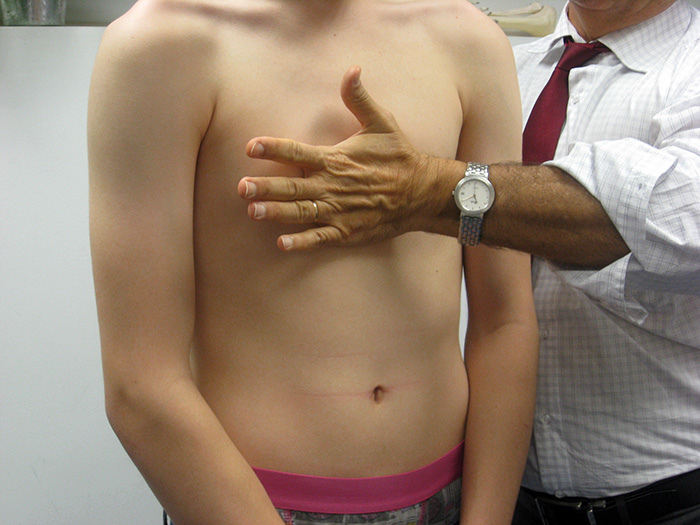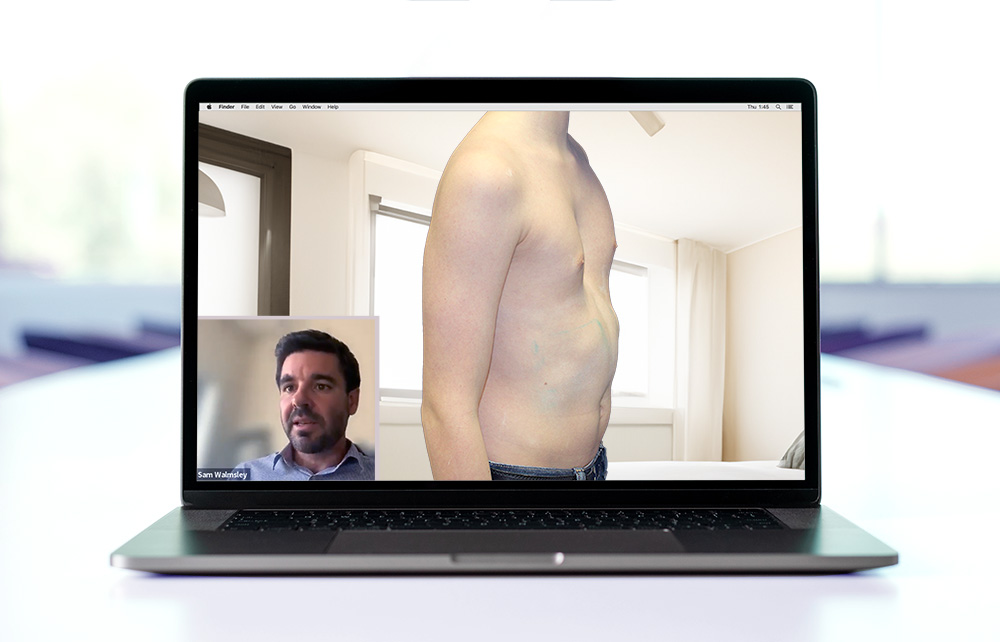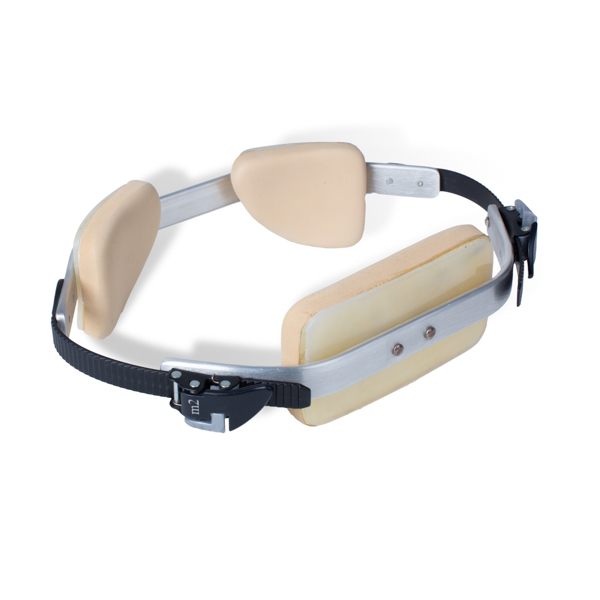An introductory, face-to-face consultation with one of our pectus specialists covers the following:
This initial consultation costs £192 and there is no obligation to go ahead with treatment. If you’re unable to attend this appointment please give us at least 48 hours’ notice, to avoid charges.
Please note that patients under the age of 18 must be accompanied by a parent or legal guardian for all appointments.

Our comprehensive treatment package for pectus carinatum includes:
Treatment for adolescent pectus carinatum patients can take anywhere between six months and two years to complete. This will vary depending on the age of the patient, the flexibility of their chest and their compliance with the brace-wearing regime.
Our comprehensive treatment package for pectus excavatum is similar, but includes:
While not all patients will require a bespoke rib flaring brace, in certain cases this brace can radically improve the appearance of the sunken area of the chest. You will be advised by your clinician if a bespoke rib flaring brace is right for you.
Treatment for adolescent pectus excavatum patients can take anywhere between a year to 18 months, depending on the patient. This will vary depending on the age of the patient, the flexibility of their chest and their compliance with the brace-wearing regime.
For patients considering our non-surgical treatment for pectus excavatum or pectus carinatum, we offer a free initial pectus consultation via Skype, Facetime or Zoom.
During this session, one of our pectus clinicians will establish the severity of the condition and discuss possible treatment options.
Find out more about our free, virtual initial pectus appointments

| Initial virtual consultation for either pectus carinatum or excavatum patients - 30 minutes | Free |
| Face-to-face consultation | £192 |
| Full Pectus Carinatum Treatment Package, which includes: | |
| - Dynamic Chest Compressor Bespoke Brace | £900 |
| - Adult Treatment Contract (includes fitting and up to two years of review appointments) | £2,200 |
| - Under 18 Year Olds Treatment Contract (includes fitting and up to two years of review appointments) | £1,800 |
| Rib Flaring Bespoke Brace (if required)* | £900 |
| Full Pectus Excavatum Treatment Package, which includes: | |
| - Vacuum Bell orthosis | £900 |
| - Adult Treatment Contract (includes fitting and up to two years of review appointments) | £2,200 |
| - Under 18 Year Olds Treatment Contract (includes fitting and up to two years of review appointments) | £1,800 |
| Rib Flaring Bespoke Brace (if required)* | £900 |
| *Please note: Not all pectus patients will require two braces for their treatment. Rib flaring braces are not included in the treatment package prices and are charged for separately. |
LOC's comprehensive treatment package for chest deformity includes the following services and support.
Each pectus patient will be given a comprehensive wear and care guide which covers the most frequently asked questions we receive about wearing both the dynamic chest compressor and the vacuum bell orthosis.
The bespoke exercise programme actively improves the flexibility of the chest, and pressure applied from the pads enables remodelling of the skeletal system to take place.
These exercises are individually designed by a physiotherapist and if completed during brace treatment will help to change the length and strength of muscles.
This is very important for when a patient is coming to the end of bracing treatment, to ensure out-of-brace posture is central and balanced and without muscle distortion. This increases the chance of sustaining the improvements made.
At the end of bracing treatment, most patients who have completed bracing or vacuum bell therapy will not need ongoing exercises to maintain their new corrected posture.
Our braces and orthoses are designed to be worn every day. While the dynamic chest compressor and rib flaring brace are robust and durable, we appreciate that damage can happen through everyday use.
In the event of your brace(s) or vacuum bell orthosis breaking or becoming faulty in the first two years of treatment, we will repair it in our on-site manufacturing workshop for no extra cost.
Please note, if additional braces or vacuum bells are required, these will be charged for separately.

Dynamic chest compressor brace for pectus carinatum
Patients and their parents will be offered the direct email addresses of the treating orthotist so they can contact them when they need.
Between review appointments, our admin team can set up face-to-face appointments, as well as appointments by phone or video call with your clinician to discuss any concerns or questions you may have.
Our breadth of knowledge at LOC means we can offer additional insight into underlying conditions that can contribute to the appearance of chest deformity. This means we can recommend additional postural and biomechanical assessments that can improve outcomes for pectus patients.
This depends on several factors; the position of the chest wall deformity, its severity, the flexibility of the chest, the kind of results wanting to be achieved and the age of the person undergoing treatment for pectus excavatum or pectus carinatum.
Early adolescence (roughly between the ages of 12-16 years old) – is an optimum age to start treatment, given that the chest is still maturing, and flexible, permanent correction is more easily achievable. Once bracing treatment is complete and a patient has stopped growing, the deformity will not return. For younger pectus patients, conservative bracing is used to keep a deformity from worsening and can help them to avoid surgery in later life.
For older pectus patients (between the ages of 20 to 30) results can be harder to achieve, as the costal cartilage hardens into the bone as a person matures. Over the years we have successfully treated many adults for both pectus excavatum and pectus carinatum and active adults with flexible chests can expect good results.
Again, this hugely depends on what a patient wants to achieve from treatment; whether that’s avoidance of surgery, improvement in the appearance of the chest shape, reduction in rib flaring etc. All these goals are taken into consideration during your first consultation. While there are no serious health risks of having pectus carinatum or excavatum – beyond the cosmetic – for many patients and parents, treatment outcomes involve improving confidence and self-esteem. During our 2018 Pectus Patient Survey, 92% of pectus carinatum patients surveyed said that treatment had a ‘major improvement’ or ‘an improvement’ on their social life.
You can read the results of our 2018 Pectus Patient Survey and quality of life questionnaire here.
Regular reviews are part of the treatment programme, preferably in clinic with one of our specialist orthotists, or via Skype consultations.
The number of appointments needed will vary from patient to patient but as a general rule, younger pectus patients who are growing at a faster rate will need to be seen more regularly for check-up appointments. This is to ensure that the brace fits well and is guiding the chest into the correct position as growth spurts occur. For other patients, this can be scaled back according to their individual needs and demands.
Regular appointments are beneficial for assessing progress, checking for signs of rubbing and determining whether another brace is needed. Appointments are also good for checking patient compliance to brace wearing and the breathing and exercise programme. At each appointment, we make time for patients to see our physiotherapist to fine-tune their exercise programme and check to see how a patient has been managing with the current programme.
We always advise coming in for appointments whenever you have any concerns about the brace or treatment programme, especially if a brace is rubbing or not fitting correctly. At the London Orthotic Consultancy, we have treated numerous international patients that have benefitted from specially designed braces that leave room to accommodate for growth and that can be adjusted remotely. Follow-up appointments for international patients are conducted via Skype.
This is a very common concern for patients considering treatment; in general, the dynamic chest compressor brace is easy to conceal if you are wearing a loose-fitting shirt for school or work. If you are wearing two chest braces – one for the main deformity and the other for rib flaring – then this may be more noticeable, especially under a t-shirt. Normally loose-fitting clothing will conceal the brace, though it’s likely it will be seen through tight-fitting clothes.
It is really important to continue exercising while going through bracing treatment. Exercise is fundamental to keeping the chest wall flexible. Our treatment programme incorporates a daily exercise routine of around 30-40 minutes of stretching using yoga poses, resistance bands, deep breathing exercises and general muscle stretches. Deep breathing exercises allow the lungs to expand against the chest wall, pushing it outwards.
Exercising with the brace on in the later stages of treatment can also make the chest correction more stable and permanent.
Swimming is one of the best forms of exercise to complement bracing treatment, as the body positions required to swim imitate the resistance band training designed to stretch the chest and increase its flexibility. Some swimming strokes are better for this than others, please check with your clinician. The brace should always be removed for contact sports and for swimming.
For most patients, one brace is often all that is needed to achieve a desired level of correction. They are each designed to last the duration of treatment and accommodate any growth that may occur in that time. Some patients have benefitted from having two braces – one to treat the main deformity and the other to treat rib flaring. For some pectus excavatum patients, having a brace apply pressure to the ribs – in addition to vacuum bell therapy – can greatly reduce the appearance of the depressed sternum area of the chest, forcing it upwards and outwards into a more corrective position.
If you are worried about your chest shape, or your child’s chest shape, then get in touch for a free Skype consultation with one of our pectus specialists who can assess their chest and discuss treatment options. We are always happy to communicate with local GPs, thoracic surgeons and consultants if a patient approaches us for bracing treatment after considering other options.

LOC's non-surgical treatment for pectus involves the Dynamic Chest Compressor, a custom made orthosis designed for an individual’s anatomy to specifically treat their particular type of pectus. For Pectus Excavatum patients we also prescribe the Vacuum Bell - it works by using a silicone cup and a vacuum pump to create an area of low pressure over the sunken part of the chest.
We manufacture bespoke braces for each patient, ensuring comfort and ease of compliance during treatment.

Information and price lists for our comprehensive pectus excavatum and pectus carinatum treatment packages, which include personal support throughout treatment, a bespoke exercise regime and physiotherapy support.
All fees associated with your treatment are included, such as appointments required for the duration of treatment.

We offer free online pectus excavatum and pectus carinatum consultations via Skype, Facetime or Zoom for those worried about their chest shape.
Our treatment programme will be explained in detail so you can see whether treatment is right for you.

The London Orthotic Consultancy has been providing non-surgical pectus treatment since 2010 achieving positive results in our patients.
We are proud to be the pioneers of this treatment in the UK and are happy to share some patient successes for those who have undergone Pectus Carinatum treatment with us.

The London Orthotic Consultancy has been providing non-surgical pectus treatment since 2010 achieving positive results in our patients.
We are proud to be the pioneers of this treatment in the UK and are happy to share some patient successes for those who have undergone Pectus Excavatum treatment with us.

LOC director and pectus specialist, Sam Walmsley, has recorded a series of videos answering our client's frequently asked questions about our pectus treatments and exercise programmes.
For patients who want to avoid surgery, non-surgical pectus treatment can be a great way to achieve a flatter chest, but often, patients are unsure of what treatment involves.

We offer orthotic treatment for international patients seeking non-surgical pectus excavatum and pectus carinatum bracing in the UK. Our specialist clinicians have extensive experience treating pectus deformity patients from around the world.
We regularly treat international patients with our evidence-based orthotics including those from Europe, South America and the Middle East.

Pectus carinatum, also known as 'pigeon chest' is a congenital deformity of the anterior chest wall, and occurs when the breast bone (or sternum) is pushed outward by an abnormal overgrowth of cartilage.
Orthotic bracing is proven to be a safe and effective way to provide successful outcomes without surgical intervention.
For patients considering our non-surgical treatment for pectus carinatum, we offer a free online consultation with one of our pectus specialists.

Pectus Excavatum, also known as 'funnel' or 'sunken' chest, is where the breast bone is pushed abnormally inward.
It is the most common form of congenital chest deformity which tends to become exaggerated during puberty where growth spurts cause the cartilage and bones to grow at a rapid rate.
For patients considering our non-surgical treatment for pectus excavatum, we offer the opportunity for an initial free consultation via Skype, Facetime or Zoom.

“It’s life-changing, my swimming coach has even remarked what a difference my treatment has made" Read how pectus bracing treatment helped to correct Aris' complex chest deformity, involving a combination of pectus excavatum, pectus carinatum and rib flaring.

Cerebral palsy patient Lucas sees significant improvement in his walking after only six months in his new custom Ankle Foot Orthoses (AFOs), designed by Professor Saeed Forghany in our Manchester clinic. Hear how a detailed gait analysis and bespoke AFOs significantly improved Lucas's gait and comfort.

Freddie’s positional plagiocephaly was treated successfully with the LOCBand Lite, going from 11mm to 2mm after four months in his helmet.

Adult club foot (talipes) patient Natasha says, "I cannot stress how amazing my AFOs are and how they have changed so much for me. The support they give me allows me to walk without crutches outside the house for the first time in over fifteen years."

Diagnosed with adolescent idiopathic scoliosis at 14 years old, Polly and mum Zoe looked to the LOC Scoliosis Brace to help her curve and avoid surgery at a later date.

LOC opens its first clinic in Northern Ireland, LOC Belfast, offer non-surgical orthotic treatment for scoliosis, pectus carinatum and pectus excavatum. Here, we will also be able to provide orthotic treatments for a range of adult and paediatric lower limb conditions including cerebral palsy, spina bifida, hypermobility, stroke, post-polio syndrome, and multiple sclerosis.

Mum Natalie shares her experience of having both her identical twins diagnosed with craniosynostosis. Ella and Nina had surgery at Great Ormond Street Hospital before going through cranial remoulding therapy at the London Orthotic Consultancy.

See how a thorough gait analysis and a correctly-fitted, bespoke Reciprocating Gait Orthosis (RGO) helped Ted, a spinal surgery and cancer survivor, improve his rehabilitation and mobility goals, getting him back on his feet again.